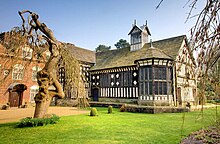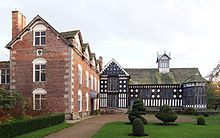Rufford Old Hall
The Rufford Old Hall is a country house in Rufford in Lancashire . Sir Robert Hesketh had it built around 1530. The knight's hall is the only building in the complex that has been preserved to this day. A brick wing in Jacobean style was added at right angles to the knight's hall in 1661, and another wing was added in the 1820s.
Rufford Old Hall has been rated Grade 1 by English Heritage , a farmhouse, coach house, and stables located about 10 meters east of the Great Hall as Grade 2.
history
Until 1936, Rufford Old Hall was permanently owned by the Hesketh family , who had been Lord of the Manor of Rufford since the 15th century . In 1798 the family moved to Rufford New Hall . In 1846 Sir Thomas Hesketh, 5th Baronet , married Lady Anna Maria Arabella Fermor , sister and heir to George Fermor, 5th Earl of Pomfret .
There is evidence that Shakespeare is said to have played theater in the great hall. Around 1580 Shakespeare was appointed by his schoolmaster from Stratford-upon-Avon as an assistant teacher in the household of Alexander Hoghton in Lea Hall near Preston , and the "wilim Shakeshaft nowe dwellynge with me" (German: "Willim Shakeshaft, who now with me lives ”), to which Hoghton refers in his will, is almost certainly Shakespeare. Hoghton, who died in 1581, bequeathed his musical instruments and “play clothes” to Sir Thomas Hesketh in his last will. By around 1585 Shakespeare had joined Lord Stange's Men , a theater company with Lord Strange , son of Lord Derby, after being recommended by Sir Thomas Hesketh. In her 1974 book Lancashire Legends , Kathleen Eyre posits that although "it would be nothing more than a pious hope" that "William Shakeshaft" (a common version of Shakespeare's name) would have been a young member of the Hesketh Company of Players , the performed in Rufford around 1585. This time coincides with Shakespeare's absence from Stratford-upon-Avon after deer theft in neighboring parks, particularly that of Sir Thomas Lucy in Charlecote .
In 1936, Thomas Fermor-Hesketh, 1st Baron Hesketh donated Rufford Old Hall with its weapons and armaments collection and 17th century oak furniture to the National Trust.
architecture
The half-timbered house with the Knights' Hall in late medieval construction, which even at the time of the Tudors continued to be cultivated, let Sir Robert Hesketh built around 1530th The hall that formed the south wing is still essentially in the same condition as it was after its completion, 14.2 meters long and 6.7 meters wide. The framework sits on a low stone wall. The hall has a tiled floor, a stone fireplace, five bay windows and a hammer-beam vault . The five hammer beams bear a carved angel on each side. One overlooks the hall from a four-leaf hagioscope in an archway of the salon on the second floor.
In 1661 a brick wing in Jacobean style was added at right angles to the knight's hall. It contrasts with the medieval building with the black and white wood structure. This wing was built from small, two-inch bricks, similar to Bank Hall , Carr House, and St Michael's Church in Much Hoole . The west wing, which housed the living quarters for the family, may have been destroyed by fire.
In the 1820s, a third wing was built in place of the medieval servants' quarters and a castle-like tower was built between the knight's hall and the Karl II wing. In 1949 a secret room, which served as a priest's hole in the 16th century , was discovered above the knight's hall.
inside rooms
A free-standing, carved wood facing made of bog wood in the knight's hall is dated between 1530 and 1540. Nikolaus Pevsner describes it as “an extraordinary ornament that is unmatched anywhere in England.” It is the only surviving specimen from the first half of the 16th century. The facing stands on the north wall of the great hall and covers the original entrance to the kitchen wing. It has three spiral finials , two outer ones carved from a single wooden board on the side of the facing, which frame eight tracery. On the upper beam are two angels, one male and one female, bearing shields with the coats of arms of the Fitton and Banastre families . Two horizontal bars are mortised to the vertical bars. The artisans probably made three mistakes to avoid being accused of heresy , as it was believed at the time that only God could create something perfect: one beam on the side of the hall is installed upside down, on the opposite side one beam has another Pattern and an angel has an extra finger.
In the stairwell there is a painting by Godfrey Kneller showing Thomas Hesketh, who was Preston's second member of parliament in 1722 and had the second wing built in the 1720s, together with his wife Martha and his son in 1723.
In the living room there is a copy of a map of Lancashire made by Christopher Saxton from 1577.
Gardens
Behind the country house and to the side of it there are gardens and grassland and in front of it there is light forest. A section of the Leeds-Liverpool Canal , completed in 1781, runs a little east of the property. A remarkable detail of the garden is a pair of hedges cut into the shape of a ground squirrel.
Ghosts
The gray woman , Elizabeth I , and a man in Elizabethan clothing are said to be haunted in the knight's hall . A male figure has also been seen hovering over the canal at the rear of the building. On February 20, 2010, the team for the paranormal television series Most Haunted was filming at Rufford Old Hall.
Individual evidence
- ↑ a b c d e R. Dean: Rufford Old Hall . The National Trust 2007. ISBN 978-1-84359-285-3
- ^ Rufford Old Hall . English Heritage. Retrieved December 23, 2014.
- ↑ Cottage, Coach House and Stables about 10 meters East of Wing of Rufford Old Hall . English Heritage. Retrieved December 23, 2014.
- ↑ a b K. Eyre: Lancashire Legends . Clapham, Lancaster, Dalesman 1974. ISBN 1-85568-046-7
- ^ Rufford in William Farrer, J. Brownbill (editor): A History of The County of Lancaster . Volume 6. British History Online 1911. pp. 119-128 . Retrieved December 23, 2014.
- ↑ a b Rufford Old Hall, Rufford . Listed Buildings Online . Retrieved December 23, 2014.
- ^ Bretherton in William Farrer, J. Brownbill (editor): A History of The County of Lancaster . Volume 6. British History Online 1911. pp. 102-108 . Retrieved December 23, 2014.
- ^ Rufford Old Hall . TourUK ( Memento of the original from 23 August 2010 in the Internet Archive ) Info: The archive link was automatically inserted and not yet checked. Please check the original and archive link according to the instructions and then remove this notice. . Retrieved December 23, 2014.
- ↑ a b The Moveable Screen . Brochure about the knight's hall. National Trust.
- ↑ Thomas Hesketh (1698–1735), MP, His Wife Martha St Amand (d.1782), Mrs Thomas Hesketh, and a Son . bbc.co.uk. Retrieved December 23, 2014.
- ↑ This Week's Highlights - Haunted Lancashire . BBC Inside Out. September 12, 2005 . Retrieved December 23, 2014.
- ^ J. Karl: Haunted Places in Lancashire - Rufford Old Hall . 2006. pp. 73-75
Web links
- Shakespeare at Rufford? BBC - Liverpool. November 13, 2014.
- Rufford Old Hall . National Trust
- RUFFORD and the HESKETHS . heskethbank.com
- Photos of the Rufford Old Hall. National Trust.
Coordinates: 53 ° 38 ′ 16.5 " N , 2 ° 48 ′ 49.3" W.




